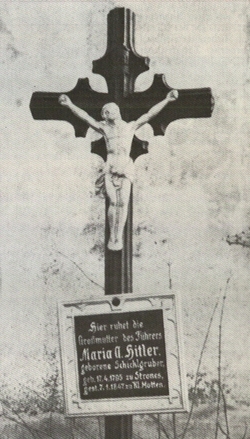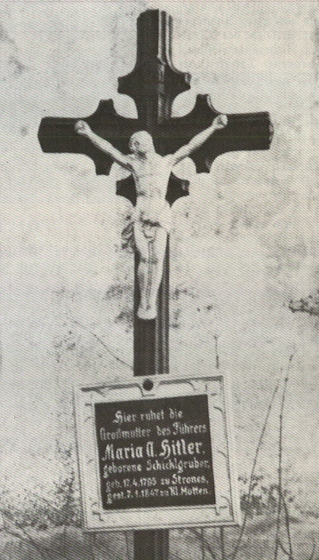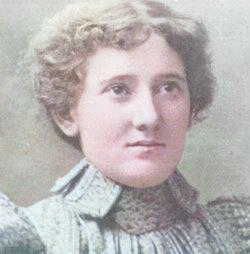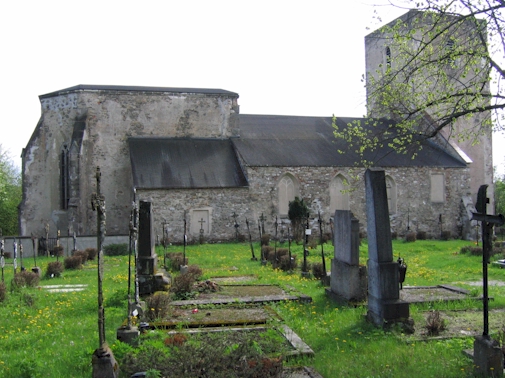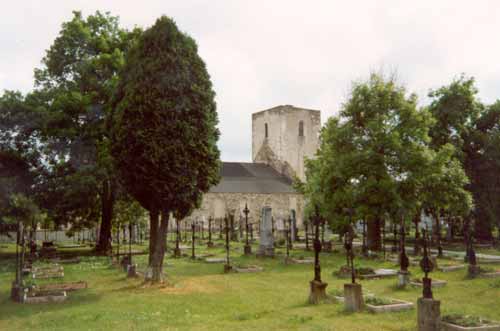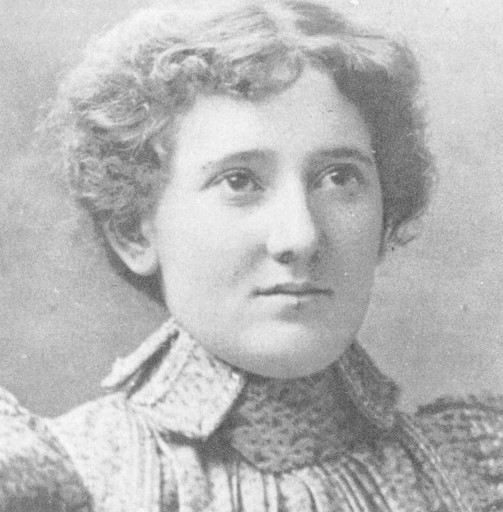She was born in the tiny village of Strones in the Waldviertel, in northwest Lower Austria just northwest of Vienna. She was the daughter of Theresia Pfeisinger (1769 - 11 November 1821), and farmer Johannes Schicklgruber (29 May 1764 - 12 November 1847). Maria was Catholic; what is known about her is based on church and other public records.
She was one of 11 children, only six of whom survived infancy. Her early life was that of a poor peasant child in a rural German-speaking town. The area she lived in is known as the Waldviertel, a hilly, forested area, picturesque but poor, in the northwest part of Lower Austria, northwest of Vienna.
Maria's mother died in 1821 when Maria was 26. She received an inheritance of 74.25 gulden, which she left invested in the Orphans' Fund until 1838. By that time it had more than doubled to 165 gulden. At that time, a breeding pig cost 4 gulden, a cow 10-12 gulden and an entire inn 500 gulden. Werner Maser wrote she was a "thrifty, reserved, and exceptionally shrewd peasantwoman."
Other than saving her inheritance, which indicates she was not destitute during that period of her life, little is known about Maria's life until she was over 40. In 1837 she was 42 years old, and still single, when her first and only child was born. She named the boy Alois. Maser notes that she refused to reveal who the child's father was, so the priest baptized him Alois Schicklgruber and entered "illegitimate" in place of the father's name on the baptismal register. Historians have discussed three candidates for the father of Alois:
Johann Georg Hiedler, who in his lifetime was the stepfather and later legally declared as the birth father.
Johann Nepomuk Hiedler, Georg's brother and Alois's step-uncle, who raised Alois through adolescence and later willed him a considerable portion of his life savings but who (if he was the real father) never found it expedient to admit it publicly.
Leopold Frankenberger, claimed by Hans Frank to have fathered Alois when his mother Maria worked in the Frankenberger house as a maid in Graz, Austria.
At the time of his birth, she was living with a Strones village family by the name of Trummelschlager. Herr and Frau Trummelschlager were listed as godparents to Alois.
Maria soon took up residence with her father at house #22 in Strones. After an unknown period, the three Schicklgrubers were joined by Johann Georg Hiedler, an itinerant journeyman miller. On 10 May 1842, five years after Alois was born, Maria Anna Schicklgruber married Johann Georg Hiedler in the nearby village of Döllersheim. Maria was 47, her new husband was 50.
Maser suggests that if Hiedler had been the biological father of Maria's son Alois the couple would have acknowledged it when they married. There was a church procedure for such things, but Alois remained officially born out of wedlock during their lifetimes. Maser asserts Johann Georg Hiedler was not Alois' biological father (and hence not Adolf Hitler's grandfather) as Alois later claimed, but there is no proof either way. The question became important when Hitler began to seek power, and one of Nazism's principles was that to be considered a German one had to have a documented ancestry (see Alois Hitler).
Some time after Maria was married (but no more than five years later) Alois was sent to live with Johann Georg's brother, Johann Nepomuk Hiedler, who had a modest but prosperous farm in the village of Spital. Maria and Johann Georg then moved to Klein-Motten. The reason why Alois was sent away is not known. There is some speculation that Johann Nepomuk may have been Aloys' biological father.
Maria died during the sixth year of her marriage, at the age of 52 in Klein-Motten where she was living with her husband in the home of kin, the Sillip family. She died of "consumption resulting from pectoral (thoracic) dropsy" in 1847. She was buried at the parish church in Döllersheim.
After the Nazi takeover of Austria in 1938, a search failed to find her grave so she was given an "Honor Grave" next to the church wall. This grave was tended by local Hitler Youth groups. In 1942, this area became part of an artillery training area and the local inhabitants were moved out. Military training continued under the Soviets after 1945, and also under the Austrian Army until about 1985, by which time most of the towns and villages were in ruins. The church at Döllersheim is now preserved and undergoing reconstruction. The cemetery is being tended, but there is no grave marker there now for Maria Schicklgruber.
Some Schicklgrubers remain in Waldviertel. One of this extended clan, "Aloisia V" aged 49, died in 1940, in an Austrian Nazi gas chamber.
She was born in the tiny village of Strones in the Waldviertel, in northwest Lower Austria just northwest of Vienna. She was the daughter of Theresia Pfeisinger (1769 - 11 November 1821), and farmer Johannes Schicklgruber (29 May 1764 - 12 November 1847). Maria was Catholic; what is known about her is based on church and other public records.
She was one of 11 children, only six of whom survived infancy. Her early life was that of a poor peasant child in a rural German-speaking town. The area she lived in is known as the Waldviertel, a hilly, forested area, picturesque but poor, in the northwest part of Lower Austria, northwest of Vienna.
Maria's mother died in 1821 when Maria was 26. She received an inheritance of 74.25 gulden, which she left invested in the Orphans' Fund until 1838. By that time it had more than doubled to 165 gulden. At that time, a breeding pig cost 4 gulden, a cow 10-12 gulden and an entire inn 500 gulden. Werner Maser wrote she was a "thrifty, reserved, and exceptionally shrewd peasantwoman."
Other than saving her inheritance, which indicates she was not destitute during that period of her life, little is known about Maria's life until she was over 40. In 1837 she was 42 years old, and still single, when her first and only child was born. She named the boy Alois. Maser notes that she refused to reveal who the child's father was, so the priest baptized him Alois Schicklgruber and entered "illegitimate" in place of the father's name on the baptismal register. Historians have discussed three candidates for the father of Alois:
Johann Georg Hiedler, who in his lifetime was the stepfather and later legally declared as the birth father.
Johann Nepomuk Hiedler, Georg's brother and Alois's step-uncle, who raised Alois through adolescence and later willed him a considerable portion of his life savings but who (if he was the real father) never found it expedient to admit it publicly.
Leopold Frankenberger, claimed by Hans Frank to have fathered Alois when his mother Maria worked in the Frankenberger house as a maid in Graz, Austria.
At the time of his birth, she was living with a Strones village family by the name of Trummelschlager. Herr and Frau Trummelschlager were listed as godparents to Alois.
Maria soon took up residence with her father at house #22 in Strones. After an unknown period, the three Schicklgrubers were joined by Johann Georg Hiedler, an itinerant journeyman miller. On 10 May 1842, five years after Alois was born, Maria Anna Schicklgruber married Johann Georg Hiedler in the nearby village of Döllersheim. Maria was 47, her new husband was 50.
Maser suggests that if Hiedler had been the biological father of Maria's son Alois the couple would have acknowledged it when they married. There was a church procedure for such things, but Alois remained officially born out of wedlock during their lifetimes. Maser asserts Johann Georg Hiedler was not Alois' biological father (and hence not Adolf Hitler's grandfather) as Alois later claimed, but there is no proof either way. The question became important when Hitler began to seek power, and one of Nazism's principles was that to be considered a German one had to have a documented ancestry (see Alois Hitler).
Some time after Maria was married (but no more than five years later) Alois was sent to live with Johann Georg's brother, Johann Nepomuk Hiedler, who had a modest but prosperous farm in the village of Spital. Maria and Johann Georg then moved to Klein-Motten. The reason why Alois was sent away is not known. There is some speculation that Johann Nepomuk may have been Aloys' biological father.
Maria died during the sixth year of her marriage, at the age of 52 in Klein-Motten where she was living with her husband in the home of kin, the Sillip family. She died of "consumption resulting from pectoral (thoracic) dropsy" in 1847. She was buried at the parish church in Döllersheim.
After the Nazi takeover of Austria in 1938, a search failed to find her grave so she was given an "Honor Grave" next to the church wall. This grave was tended by local Hitler Youth groups. In 1942, this area became part of an artillery training area and the local inhabitants were moved out. Military training continued under the Soviets after 1945, and also under the Austrian Army until about 1985, by which time most of the towns and villages were in ruins. The church at Döllersheim is now preserved and undergoing reconstruction. The cemetery is being tended, but there is no grave marker there now for Maria Schicklgruber.
Some Schicklgrubers remain in Waldviertel. One of this extended clan, "Aloisia V" aged 49, died in 1940, in an Austrian Nazi gas chamber.
Family Members
Advertisement
See more Hitler or Schicklgruber memorials in:
- Doellersheim Church Cemetery Hitler or Schicklgruber
- Dollersheim Hitler or Schicklgruber
- Zwettl Bezirk Hitler or Schicklgruber
- Lower Austria Hitler or Schicklgruber
- Austria Hitler or Schicklgruber
- Find a Grave Hitler or Schicklgruber
Records on Ancestry
Sponsored by Ancestry
Advertisement
